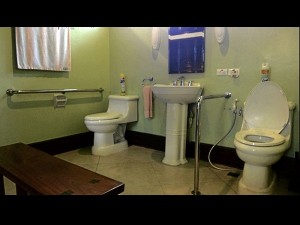
GRAB BARS and raised toilet seats are features of green homes for the elderly. PHOTO BY A.P. de Jesus & Associates—Green Architecture
A few years ago, I wrote about designing for the elderly and the disabled. Both the elderly and the disabled and those who assist them are benefited when homes are designed with their special needs in mind.
Filipinos give special attention and love to old members of the family. The old people are loved and revered for giving witness to the past, and for transferring culture to the young. The elderly have more time with the family and therefore they help to give life to the family reality. The presence of grandparents helps retain the art of conversation among family members which is getting lost nowadays.
Economic prosperity in most countries has led to a graying population. People prefer to make more and more money. The sexual revolution is another profound movement in man’s history that has contributed to depopulation. The duality of the sexes is being obscured by the notion that it is a mere result of cultural conditioning. Naturally a species that refuses to reproduce is doomed for extinction.
World’s irreversible crisis
According to the Moscow Demographic Summit of June 2011, nearly half of all mankind today are living in countries where the birth rate is no longer able to replace the older generation, and that depopulation is the world’s next irreversible crisis.
The breakdown of families has resulted in high energy consumption if husband and wife divorce and maintain separate households. Today there are more households than marriages in the United States where the number of households with children is only half the number of households without children.
In the United States, many are adopting the concept of green homes with 6 to 10 elders. The concept is trying to get rid of the old model of the nursing home as older adults who are frail do not have to live in institutions.
Many Americans believe that housing elders in green homes with qualified attending nursing assistants is a better way to preserve the dignity and autonomy of the elderly, providing better care while keeping them connected to the community.
What is meant by green homes for the elderly?
First, green homes are designed for sustainability—and felixibility. This means they are well suited to occupants’ needs and are flexible enough to undergo minimal renovations as occupants’ needs vary.
The hazards posed by construction dust and pollution affect the indoor-air quality and the health of the occupants, especially the elderly with respiratory problems.
Eliminate steps, thresholds
Green homes for the elderly eliminate steps and thresholds that can cause accidents. Ramps are provided with an ideal slope of 1:12. This means that for every one foot vertical rise, a 12 feet horizontal distance must be provided to allow easy access of a person in a wheel chair.
Doors and corridors need to have a minimum width of 36 inches for easy access of a wheel chair. When these design features are incorporated at an early stage, future alteration costs can be reduced significantly.
Enhancing mobility
To facilitate their movement, there should be sufficient space for them to maneuver, whether they use wheelchairs or crutches. They should have a clear area in each room for a circular space of about five feet to allow a person in a wheelchair to turn around.
About 36 inches of space should be provided in front of shelves and cupboards and at least 18 inches of space between the lavatory and the water closet.
Other special amenities include designing the kitchen sink with kneespace under the sink instead of the usual cabinet. For the kitchen range, new models are available without the oven compartment below.
Shower compartments with elevated thresholds should be avoided. A better solution is to slope the floor toward the drain. A nonskid type of flooring for the toilet, especially for the shower is a basic necessity.
Light switches should also be installed at a height that is accessible from a sitting position.
Door knobs and lavatory faucet handles of the lever type are preferable to the round type, especially for those with arthritis.
Safety features
Among the safety features are grab bars placed in showers and around the toilet fixtures.
Low window sills provide better views of the outdoor, bring in more daylight and make it easier for a person in a wheelchair to open windows.
The accessibility law in the country was designed for the enhancement of the mobility of disabled persons for certain buildings and institutions. It does not cover private homes and residences. However, this should not stop designers from considering this important element in their projects.
For comments or inquiries, email amadodejesus@ gmail.com.

